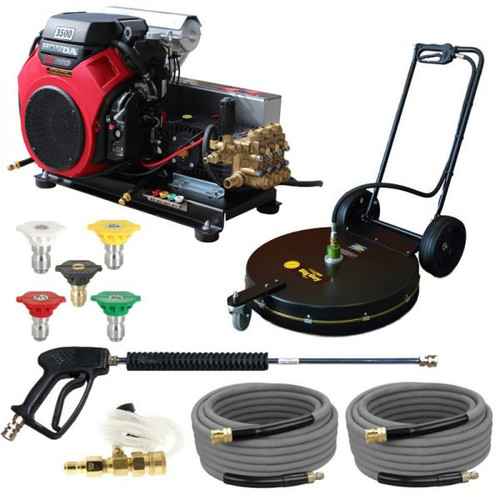How to Use a Pressure Washer | Best Practices and Pro Tips
07/ 25/ 2024 by Jeff

Introduction to Pressure Washing
Pressure washing, also known as power washing, uses high-pressure water spray to remove dirt, grime, mold, mildew, and other contaminants from surfaces like buildings, vehicles, and concrete.
It’s tough work if you don’t know the ins and outs, which is why it’s important to do your homework. Proper pressure washing technique is effective for maintaining the appearance and cleanliness of various surfaces and can also prevent damage caused by contaminants over time.
We also recommend checking out OSHA safety guidelines, and passing this knowledge on to anyone in the industry who needs it.
Let’s take a look at equipment needs and standard approaches.
Pressure Washing | Equipment to Get Started
When it comes to pressure washing equipment, you’ll hear lots of varying opinions regarding the details. However, looking at it from a general standpoint, these are the key pieces of equipment to get yourself started:

Equipment Needed
- Pressure Washer: The core equipment, available in electric and gas-powered models.
- Pressure Washer Gun: Trigger gun attachment that directs high-pressure water.
- Nozzles: Different nozzles (0°, 15°, 25°, 40°, and soap) provide varying spray patterns and pressures; connected to the gun.
- Surface Cleaners: Attachments for cleaning large, flat surfaces quickly.
- Extension Wands: For reaching higher places.
- Hose: High-pressure hose to connect the pressure washer and spray gun.
Pressure Washing Technique and Procedure
Every job will have its own unique obstacles and requirements. That being said, the question of how to use a pressure washer does have a few generalized best practices. Here’s a list that covers typical pressure washing situations:
Basic Steps
- Preparation: Clear the area of debris and cover delicate plants and surfaces.
- Setup: Connect the pressure washer to a water source and power supply (if electric).
- Select Nozzle: Choose the appropriate nozzle for the job.
- Test Spray: Start with a low-pressure spray to test the effect on a small, inconspicuous area.
- Begin Washing: Maintain a consistent distance from the surface and use smooth, overlapping strokes.
- Rinse and Clean Up: Rinse the cleaned area to remove loosened debris and let it dry.
Starting a Pressure Washing Business

The pressure washing market sits at a solid $1.2 billion dollars, giving high potential for lucrative ventures if done correctly.
Begin by investing in reliable equipment, obtaining necessary licenses, and creating a solid marketing plan.
Building a client base through networking and exceptional service is the way to go. With dedication, your business will thrive, offering services to both residential and commercial markets.
We go more in depth into this topic in our “starting a pressure washing business” article, but here’s a general overview of the top considerations if you plan to embark on this venture.
Pressure Washing Business Plan
- Market Research: Identify target customers, understand local demand, and analyze competitors.
- Services Offered: Define the range of services (residential, commercial, specialty).
- Pricing Strategy: Develop a pricing model based on costs, competition, and perceived value.
Legal Considerations
- Licenses and Permits: Obtain necessary business licenses and permits for operating in your area.
- Insurance: Secure liability insurance to protect against potential damages or accidents.
Equipment Investment
- Initial Purchase: Invest in high-quality pressure washers, nozzles, surface cleaners, and safety gear.
- Ongoing Maintenance: Budget for regular maintenance and replacement of worn-out parts.
Marketing and Promotion
- Online Presence: Create a professional website and use social media to reach potential customers.
- Local Advertising: Use flyers, local newspapers, and community bulletin boards.
- Word of Mouth: Encourage satisfied customers to refer your services to others.
Client Management
- Customer Service: Provide excellent customer service to build a loyal client base.
- Scheduling and Invoicing: Use software tools to manage appointments, send invoices, and track payments.
Conclusion | Thoughts Going Forward
Starting a pressure washing business offers great potential for success with the right approach. Focus on investing in quality equipment, obtaining proper licensing, and delivering exceptional service to build a strong reputation.
As you grow, continually refine your skills, your marketing strategy, and your customer service. If you have any questions or just need some guidance, feel free to reach out to our customer support team for help! 561-964-3228

